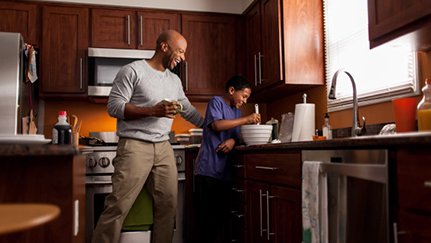Hot water heater maintenance and safety tips

Your water heater may remain unseen, hidden in a utility closet or sitting alone in a basement, but keep in mind that it needs regular maintenance for safety reasons. Make sure yours is safe, by getting to know its parts and learning some important facts.
Water heater parts
Most residential tanks hold 40 to 60 gallons and need to withstand the pressure of a residential water system (typically 50 to 100 psi.) Steel tanks are tested to handle 300 psi and have a bonded glass liner to keep rust out of the water, as well as insulation surrounding the tank. Other water heater parts include:
- A dip tube to let cold water into the tank
- A pipe to let hot water out of the tank
- A thermostat to control the temperature of the water inside the tank
- Heating elements similar to those inside an electric oven
- A drain valve that allows you to drain the tank to replace the elements, or to move the tank
- A temperature or pressure relief valve that keeps the tank from exploding
- A sacrificial anode rod to help keep the steel tank from corroding
Temperature or pressure relief valve
Temperature or pressure relief valves help prevent tanks from exploding if temperature or pressure exceeds safe limits. Unfortunately, residential valves can be prone to failure, so test this valve yearly by:
- Pulling up on the handle to make sure water flows freely out, and stops when you let go of the handle. If it does nothing or runs or drips, then the valve should be replaced.
- Flushing the hot water heater through the drain valve to remove sediment buildup. You should have a drain line, either plumbed outside or within about 6 inches of the floor to prevent you from being scalded if the valve opens while you’re next to it.
Temperature control
On residential tanks, the settings are normally warm, hot, very hot or something similar. There is so much variation on what these settings mean, but the right temperature is at least 120 degrees at the tap, which you can test with a meat or candy thermometer.
It is important to keep the temperature close to 120 degrees to kill germs and prevent children from being scaled. Compared to adults, babies and children have thinner skin that burns faster and at lower temperatures. It's a good idea to check the water temperature using your wrist or elbow every time you bathe a baby, toddler or young child. For more information about preventing burns and scalds to children visit Make Safe Happen.com.
When leaving for vacation, set the hot water heater temperature to its lowest setting. This saves money and reduces the risk of problems while you are away.
Vents
A poor draft can cause fumes and carbon monoxide to reenter the room instead of going outside. To maintain good ventilation make sure that:
- The vent is the same diameter as the tank's draft diverter
- The vent goes straight up and out, without any dips
- Where it passes through walls or roofs, it is double-walled. Single-walled vent sections should be screwed with 3 screws per section, especially in earthquake zones.
Earthquake straps
Strapping your water heater is a good idea, even if you live outside an earthquake zone. This is particularly important for maintaining gas water heater safety. If your water heater were to fall over, it could sever the gas line and cause an explosion.
Additional water heater safety tips
Keep safe by following these water heater recommendations:
- Remove paper, dust or other combustibles from the heater enclosure.
- Extinguish the pilot light before using flammable liquids or setting off aerosol bug bombs.
- If the device is in the garage, raise it so the pilot light is 18 inches above the floor. This helps prevent ignition of gasoline vapors that collect near the floor.
- Consider installing an automatic gas-shutoff valve to stop the flow of gas if the ground moves or if gas flow increases dramatically. The valve prevents fires when a gas line breaks due to flood, earthquake or other disaster.
- You may want to insulate the first six feet of the hot water pipe and the first three feet of the cold water pipe that extends from your hot water tank. Insulation reduces heat loss on the hot water pipe and "sweating” on the cold water pipe.
- Do not use pipe wrap or any other insulation within six inches of the draft hood or flue exhaust vent at the top of the natural gas water heater.
Product, coverage, discounts, insurance terms, definitions, and other descriptions are intended for informational purposes only and do not in any way replace or modify the definitions and information contained in your individual insurance contracts, policies, and/or declaration pages from Nationwide-affiliated underwriting companies, which are controlling. Such products, coverages, terms, and discounts may vary by state and exclusions may apply.
The information included here is designed for informational purposes only. It is not legal, tax, financial or any other sort of advice, nor is it a substitute for such advice. The information may not apply to your specific situation. We have tried to make sure the information is accurate, but it could be outdated or even inaccurate in parts. It is the reader’s responsibility to comply with any applicable local, state or federal regulations. Nationwide Mutual Insurance Company, its affiliates and their employees make no warranties about the information nor guarantee of results, and they assume no liability in connection with the information provided. Nationwide and the Nationwide N and Eagle are service marks of Nationwide Mutual Insurance Company. © 2024 Nationwide